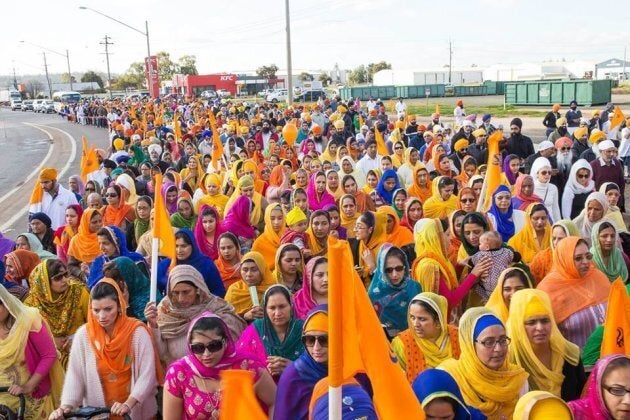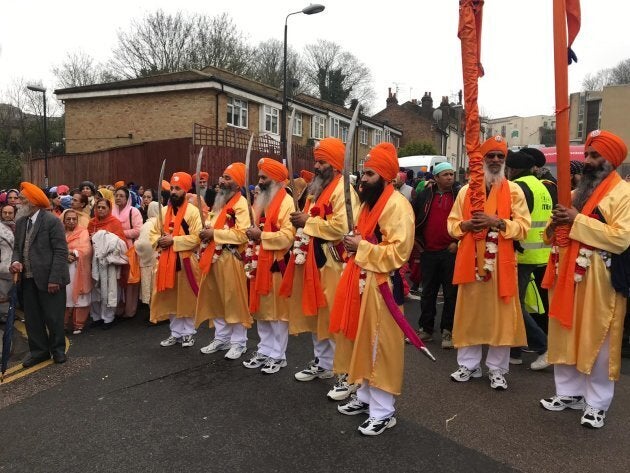We recently observed Vaisakhi, the biggest festival in the Sikh calendar. Vaisakhi marks the founding of the Khalsa — the collective of initiated Sikhs — by the tenth Guru, Guru Gobind Singh Ji. It is not, as is often said, the Sikh New Year.

In 1699, at Anandpur Sahib (in present-day Punjab, India), the Guru called for the heads of those willing to sacrifice themselves. One by one, five Sikhs came forward into a tent. They later re-emerged wearing Sikh military attire and became known as Panj Pyare: the "five beloved ones." They became the first Khalsa (initiated) Sikhs, and started a collective that today includes millions.
The occasion is celebrated by Sikhs through a nagar kirtan, or street procession of the Sikh Scriptural Guru, Guru Granth Sahib, led by five Sikhs who represent the Panj Pyare. Nagar kirtans include food, the singing of hymns and martial arts displays. Nagar kirtans are usually referred to as Sikh or Khalsa parades in North America.
Sikhs have been holding nagar kirtans in Canada for over 100 year. The first is thought to have been in 1908. Since then, they have grown to become some of the largest Sikh gatherings outside of India. The Surrey, B.C. nagar kirtan last year saw over a quarter million Sikhs and non-Sikhs participating.
Vaisakhi is more than a celebration of the past
What do you see at a nagar kirtan? Largely, everything you will see in a Gurdwara.
There will be free vegetarian food, thanks to langar — the free Sikh communal kitchen service that is found in every single Gurdwara on earth. Judging from the reaction of many, food is one of the main things people enjoy about nagar kirtans. However, as well as providing food for the stomach, Sikhs aim to provide food for the soul, too. That can come in the form of kirtan (devotional hymns).
Sikhs accompany the Guru Granth Sahib, singing shabads. Whilst hymn-singing is a normal part of most faiths, in Sikhi the music is integral to Sikh practice. All holy Sikh scripture is uniquely arranged by musical measure. Sikhs don't just remember the Divine — but through devotional music, connect to it.

One of the most visually stunning sights of a nagar kirtan is the display of gatka, a Sikh weaponry martial art. Although in the modern-day Sikh martial prowess is most commonly celebrated based on the hundreds of thousands of Allied Sikhs who participated in First and Second World Wars, the solidification of the martial aspect of the Sikhs goes back to the 1600s, when practices like gatka became crucial as Sikhs became the resistance against tyrannical Mughal rule. Through modern-day displays, you can see our readiness to defend ourselves, to defend others, and where the inspiration to do so comes from.
Swords and samosas aside, nagar kirtans are expressions of Sikh sovereignty. Guru Granth Sahib is the eternal, worldly and divine, Sikh Sovereign. Canada's Parliament was established in 1867, but even a hundred years before then, the Sikh Gurus were establishing political institutions of their own. The divine light of the Guru Granth Sahib is also embodied in the Panj Pyare, who serve a critical Sikh political function. A nagar kirtan shows not just our present, but our past, too.
Quebec Bill 21's impact on Sikh communities
The nagar kirtan is both an expression and celebration of our very being. And we invite everybody to join us at them, and to come see us for who we are.
This year it's especially important. Secularism in Quebec is nothing new, but the impending Bill 21 from its provincial government poses very real threats to estimated 15,000 Sikhs in Quebec who wish to serve there. For example, Sikhs that wish to join the police force would be prevented from joining because of their commitment to the Khalsa, the very same group that are celebrated by millions of Canadians during Vaisakhi.

Initiation into the Khalsa is more than just a baptism or confirmation — it is an unconditional dedication of one's mind, body and wealth to the Guru. Sikhs of the Khalsa — with their uncut hair, turbans and kirpans — vow to serve and protect. And yet they are the very people who will be excluded from Quebec's classrooms, courtrooms and countless other places where the Khalsa spirit could be so beneficial to all Canadians, just as it has been many a time before; from community support for those impacted by the Fort McMurray fires to the countless Sikh individuals that help their community regularly based on the Sikh belief in seva (selfless service).
More blogs from HuffPost Canada:
A Sikh's uncut hair and turban has deep spiritual and political meaning, brilliantly explained by the likes of B.C.-based poet Jasmin Kaur. It is an assertion of a confidence that should be celebrated, which should serve as a role model for schoolchildren.
When you come to a nagar kirtan, you will see the irony in the attempt to curtail the rights of individuals who proudly and defiantly stand up for the rights of others. Come to a nagar kirtan, join us and ask questions about who we are.
And perhaps ask yourself afterwards: does Bill 21 reflect how Canadian Sikhs should be treated?
Also on HuffPost: